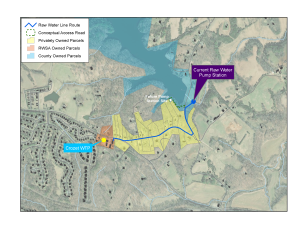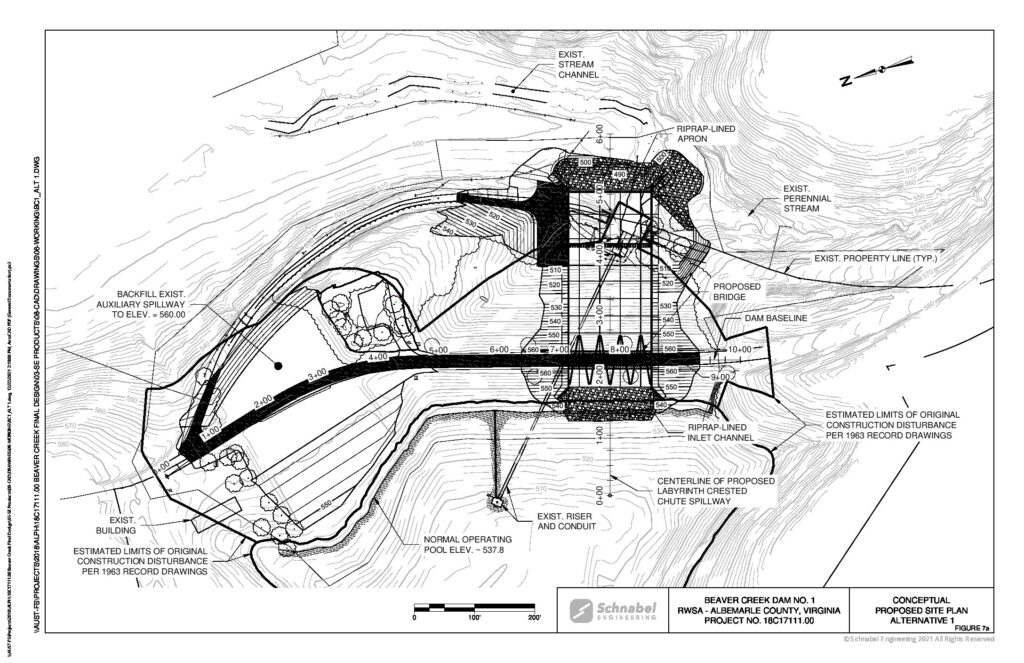The Rivanna Water and Sewer Authority has prepared a Supplemental Watershed Plan-Environmental Document (Plan-EA) for the Rehabilitation of Beaver Creek Dam. The Final Plan-EA can be viewed below:
Final Plan – Environmental Assessment
History
Beaver Creek Dam
- The Beaver Creek Dam was built in 1963 for water supply storage and flood protection. The reservoir serves as the sole raw water supply for the Crozet Water System.
- In 2011, the dam was upgraded to “high hazard” following an analysis of dam breach inundation areas and changes to the Virginia DCR Impounding Structures Regulations.
- The change in classification to high hazard requires that the capacity of the spillway be increased to store and/or pass a minimum of 90% of the probable maximum flood (PMF). The dam was originally designed to pass 60% of the PMF in compliance with design standards at the time. RWSA intends to increase the spillway capacity to allow for storage or passage of 100% of the PMF.
Beaver Creek Raw Water Pump Station and Intake
- The existing Raw Water Pump Station and Intake at the Beaver Creek Reservoir was constructed in 1964. The intake structure is located immediately upstream of the dam and is accessible via a narrow “catwalk” bridge. The pump station is located at the end of the principal spillway at the foot of the dam.
- The configuration of the raw water pump station does not allow for precise control of flow through the dam principal spillway for both the raw water pump station intake and the water released downstream. As a result, flows into Beaver Creek downstream of the dam are largely uncontrolled and can fluctuate during periods of high water demand.
- Obligatory dam safety upgrades to the Beaver Creek Dam spillway necessitate moving the pump station away from its current location downstream of the dam.
- Increasing water demands and infrastructure age in the Crozet community prompted the development of the Crozet Drinking Water Infrastructure Plan (DWIP), completed by Hazen and Sawyer (Hazen) between 2017-2019. The DWIP determined the community’s water needs for the next 50 years and established a draft protocol for new minimum instream flow (MIF) requirements. In addition to the need to upgrade pumping capacity at the raw water pump station to meet future demands, the report includes a recommendation to separate the raw water intake from the MIF release structure to lower energy requirements and simplify operations.
Hypolimnetic Oxygenation System
- In 2014, RWSA retained the services of DiNatale Water consultants and Alex Horne Associates to develop a comprehensive reservoir water quality monitoring program.
- Historically, Beaver Creek Reservoir has seen the most algae blooms out of all the Authority’s reservoirs. Algae can be harmful to the aquatic environment, complicates water treatment, and negatively affects the taste and odor of treated water. As a result, RWSA applies algaecide treatments several times each year to control these blooms.
- Following extensive reservoir water quality monitoring conducted between 2014 and 2017, DiNatale recommended installation of a hypolimnetic oxygenation system to reduce phosphorus in the reservoir, which should reduce algae and lower the number of necessary algaecide treatments required each year in the reservoir. This coupled with intake modifications would allow the withdrawal of higher quality water for much of the year, lowering water treatment costs and improving drinking water taste and odor.
Crozet Area – Drinking Water Infrastructure Plan
Details

Future Pump Station Site, Access Road, and Raw Water Main Route (click on the image for the full size map)
- Four alternatives for upgrading the capacity of the Beaver Creek Dam spillway were developed and evaluated by Schnabel Engineering. In 2018, RWSA opted to proceed with design of a 4 cycle labyrinth spillway and chute (both concrete) through the existing dam. This design will require construction of a bridge across the new spillway along Browns Gap Turnpike, and relocation of the raw water pump station, currently located at the downstream toe of the dam.
- A site selection study was completed in May of 2020 which considered six possible locations on the Beaver Creek Reservoir for the new raw water pump station and intake. The proposed pump station site is located on Albemarle County property on the west side of the reservoir. An access road to the pump station site and a new underground raw water line to the Crozet Water Treatment Plant may require easements across private property.
- The project also includes installation of a Hypolimnetic Oxygenation System (HLOS) in the Beaver Creek Reservoir to improve water quality and reduce algae growth.
- The project has a CIP budget of $42.9 M.
- Federal grants totaling $716,000 for planning and $980,250 for final design have been secured from the Natural Resources Conservation Service (NRCS) for qualifying costs related to the dam modifications. Staff will pursue federal funding in the later phases of the project to cover a portion of the dam construction costs.
Schedule
- Summer-Fall 2020: Environmental Survey
- Survey includes wetland delineation, cultural resources survey, and threatened and endangered species survey on the new pump station site, along potential access routes, and downstream of the Beaver Creek Dam to determine the extent of and minimize environmental impacts from the project.
- Fall 2020-Spring 2023 – Development of a Supplemental Watershed Plan and Environmental Assessment for the Dam and Pump Station Improvements with 100% NRCS Funding
- December 10, 2020 – Beaver Creek Dam No. 1 Public Meeting at 6pm
- October 6, 2021 @ 6pm – Beaver Creek Dam No. 1 Public Meeting #2
- Click here for the meeting link: https://www.rivanna.org/event/beaver-creek-dam-public-meeting-2/
- Public Meeting Presentation
- October 2022 – Joint Permit Application (JPA) and supporting documents submitted to review agencies
- November 4-December 19, 2022 – Formal Comment Period for Draft Plan-EA
- April 2023 – Finding of No Significant Impact (FONSI) issued by NRCS for the Final Plan-EA
- November 2023- July 2025 – Final Design of Dam Bridge and Raw Water Pump Station Improvements
- 2025-2028 – Construction of the dam upgrades, bridge, raw water pump station and intake, and Hypolimnetic Oxygenation System
For more information on this project, please contact: Victoria Fort, P.E., Senior Civil Engineer, (434) 977-2970 ext. 205 or vfort@rivanna.org
Crozet Water Treatment Plant Improvements
The Crozet water treatment system is currently permitted and rated to supply up to 1.0 million gallons per day (mgd) of water to the ACSA distribution system. Over the past several years, average day usage of water has increased steadily, with maximum day demand approaching plant capacity. In addition, much of the existing plant systems are the same as when the plant was constructed in the 1960’s. The improvements include increasing the plant’s capacity to 2.0 mgd.


